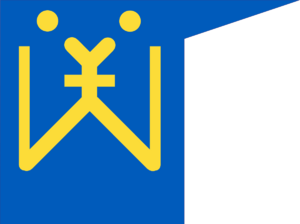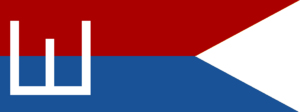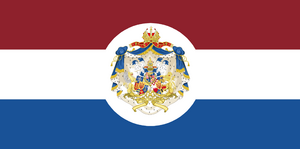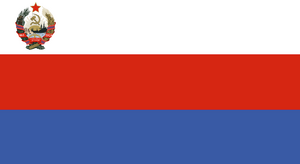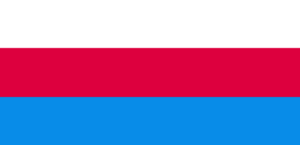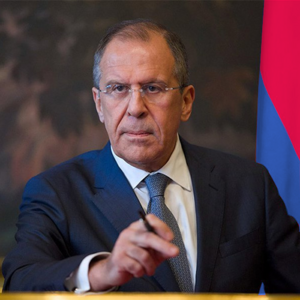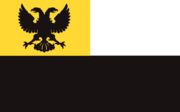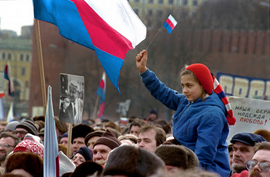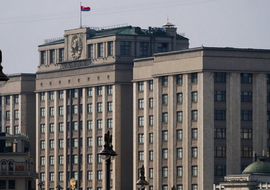Flag of Dulebia: Difference between revisions
The ©rusader (talk | contribs) m (→Modern day) |
The ©rusader (talk | contribs) |
||
| (15 intermediate revisions by the same user not shown) | |||
| Line 28: | Line 28: | ||
While the three colours of the Dulebian flag predate the Dulebian empire and were first introduced in the Middle ages, both their meaning and positioning was constantly changed together with the form of rule in the country. The tricolour was introduced for first time in the Dulebian empire after the reforms of Peter II, however, in that version the red was on top, while white was in the middle. The tricolour reappeared heavily modified as the first flag of the [[Dulebian Socialist Federative Republic]], where blue and white were once again swapped, red became the dominant colour taking up more than half the height of the flag, and white five-point star appeared in top-left. The flag was once again modified in 1928 when it received its current set-up, with only minor modifications made after the fall of socialism in Dulebia. | While the three colours of the Dulebian flag predate the Dulebian empire and were first introduced in the Middle ages, both their meaning and positioning was constantly changed together with the form of rule in the country. The tricolour was introduced for first time in the Dulebian empire after the reforms of Peter II, however, in that version the red was on top, while white was in the middle. The tricolour reappeared heavily modified as the first flag of the [[Dulebian Socialist Federative Republic]], where blue and white were once again swapped, red became the dominant colour taking up more than half the height of the flag, and white five-point star appeared in top-left. The flag was once again modified in 1928 when it received its current set-up, with only minor modifications made after the fall of socialism in Dulebia. | ||
[[Category:Dulebia]] | [[Category:Dulebia]] | ||
[[Category:National symbols in Aurorum]] | [[Category:National symbols in Aurorum]] | ||
| Line 53: | Line 52: | ||
| [[RGB color model|RGB]] || 255-255-255 || 221-0-62 || 57-90-165 || 255-199-44 || 0-0-0 | | [[RGB color model|RGB]] || 255-255-255 || 221-0-62 || 57-90-165 || 255-199-44 || 0-0-0 | ||
|} | |} | ||
{{note|alpha|α}} Used as outline | {{note|alpha|α}} Used as outline for the elements within the Coat of arms, but can occassionally be dropped in some versions of the flag. | ||
==History== | ==History== | ||
| Line 63: | Line 62: | ||
[[File:Principality of Ulich.png|thumb|Reconstruction of the first possible flag of the Principality of Ulich.]] | [[File:Principality of Ulich.png|thumb|Reconstruction of the first possible flag of the Principality of Ulich.]] | ||
The first recorded flag that was used to represent the Principality of Ulich was a blue banner with golden symbol drawn on it resebling a trident, a symbol that was later representing the city of Ulich. The origin of the banner, as well as the actual symbolism behind it, is unknown. It was found on a Lavarian map made by the merchant Ricardo Avelar, possibly created in 1041. Scientists thus suggest, that the flag was the personal banner of Prince Gavriil II, and that he adopted it as the flag of the Principality once he was throned in 1036. However, no records of the banner have survived until our days, and even the existence of this banner cannot be completely confirmed by scholars. Still, the theory that this flag was used as state flag has a lot of supporters, and it explains why a trident-like symbol later became standardized as royal symbol in the country up until the [[Dulebian Civil War]] in | The first recorded flag that was used to represent the Principality of Ulich was a blue banner with golden symbol drawn on it resebling a trident, a symbol that was later representing the city of Ulich. The origin of the banner, as well as the actual symbolism behind it, is unknown. It was found on a Lavarian map made by the merchant Ricardo Avelar, possibly created in 1041. Scientists thus suggest, that the flag was the personal banner of Prince Gavriil II, and that he adopted it as the flag of the Principality once he was throned in 1036. However, no records of the banner have survived until our days, and even the existence of this banner cannot be completely confirmed by scholars. Still, the theory that this flag was used as state flag has a lot of supporters, and it explains why a trident-like symbol later became standardized as royal symbol in the country up until the [[Dulebian Civil War]] in early 20th century. | ||
===Kingdom of Dulebia=== | ===Kingdom of Dulebia=== | ||
| Line 77: | Line 76: | ||
===Dulebian Empire=== | ===Dulebian Empire=== | ||
[[File:Dulebian_Empire_flag.png|thumb|The flag of the Dulebian Empire introduced by Peter II and serving until the Dulebian Revolution.]] | [[File:Dulebian_Empire_flag.png|thumb|The flag of the Dulebian Empire introduced by Peter II and serving until the Dulebian Revolution. Displayed above is how the flag looked in 1910, prior to the Dulebian Revolution.]] | ||
[[File:Vromm Hendrick Cornelisz A Castle with a Dutch Ship Sailing Nearby.jpg|thumb|"The Admiral rushes into battle", | [[File:Vromm Hendrick Cornelisz A Castle with a Dutch Ship Sailing Nearby.jpg|thumb|''"The Admiral rushes into battle"'', Nikolay Kasapov, 1827. Note the imperial flags on the ship.]] | ||
The Dulebian flag received a more modern outlook following the "Westernisation" reforms of Peter II the Reformator in 1721. Inspired by the flags of [[History of Mascylla|Mascyllary duchies]] and by the flag of the neighbouring Lavarian empire, the emperor decided to rework the outdated flag. Around the same time, Dulebia conquerred the tribes inhabiting the coast of the Karsk sea, led one successful war against the Cuthlandish empire, the strongest colonial power in the world at the time, and Peter II showed the neighbours of Dulebia that his country has growing ambitions in the colonisation of the world. The reformed empire soon constructed its fleet, which needed a new flag. The selection of Peter II fell on the horizontal tricolour, inspired mostly by northern states. The new flag preserved the old colours of the flag of the Dulebian kingdom, the red-blue-white combination. However, they were rearranged. Red was put on the top, as a symbol of the bravery and power of the Dulebian army. White, put in the centre, symbolised the purity of the new empire over the old kingdom, and also was used as symbol of unification of Dulebia with the western powers admired by Peter II. The blue in the bottom symbolised, before all, the Karsk sea and the naval ambitions of the new empire. | |||
During the rule of Peter II Dulebia also received its first official national symbol: the two-headed imperial eagle, bearing the shield with the trident of Ulich: at the time the symbol dating back to the Principality of Ulich had mutated to a point when its origin was already uncertain. Peter II, however, supported the hypothesis that originally it was a trident that was used as symbol of the Medieval principality. The trident was reworked and redrawn by heraldists invited from Lavaria. The red shield with golden trident became the symbol of Ulich, which was the heart of the new empire. The red shield with golden trident, on par with the imperial symbols: the sword and the orb, were held by a black two-headed imperial crowned eagle. This emblem was placed on the imperial flag; the resulting flag was used as civil and military flag. The naval flag, however, did not display the eagle - instead, it was only a horizontal tricolour. | |||
Both the imperial coat of arms and the flag itself received several modifications throughout the next two centuries: an attempte to simplify the eagle, followed by return to the original display and even the adding of new decorative elements: the royal chain of Kamianets and the new imperial crown, the modification of the bright red colour used in the flag to the more noble {{wp|bordeaux (color)|bordeaux}}, and the transition from 1:2 to 2:3 ratio for the flag. | |||
===Dulebian Socialist Federative Republic=== | ===Dulebian Socialist Federative Republic=== | ||
[[File:FlagSFRDulebia.png|thumb|The flag used by Dulebian revolutionaries and later used as the flag of the [[Dulebian Socialist Federative Republic]].]] | [[File:FlagSFRDulebia.png|thumb|The flag used by Dulebian revolutionaries and later used as the flag of the [[Dulebian Socialist Federative Republic]].]] | ||
Social unrest following the poor performance of the Dulebian army and elite during the Great war resulted in the rise of socialist movement in the country. Socialists in Dulebia adopted red as their primary colour. Red had numerous meanings for the worker movement in the country: it symbolised the blood spilled on the frontlines and during the struggle for civil rights, the valour and honour of the worker's movement, the fire of the starting world revolution, and the equality of all people in the bright future that the workers of today are building. Thus, it became the primary colour for the new flag of the newly-formed communist state. While simple red flags, red flags with white or gold stars and white flags with red stars were associated with the revolutionary movement in the early stages of the revolution and the civil war in the country, soon a standardized national flag was proposed by Viktor Shchyukin. The flag returned to the original 1:2 ratio of the first flag of Peter II; red took 1/2 of its height, while blue and white were placed in the bottom, taking the other half. A white star was introduced in the top-left corner. The flag was never oficially standardized: the stars on different flags had different sizes; some were made only as outlines, others were also filled with white; the size of the red stripe could vary from flag to flag (the one displayed features an 11:7 ratio of red). The flag remained in usage even after the death of Shchyukin, and was changed after the acception of Konev's constitution in 1928. | |||
===People's Republic of Dulebia=== | ===People's Republic of Dulebia=== | ||
[[File:FlagCommieDulebia.png|thumb|The flag adopted in 1928 as the new flag of People's Republic of Dulebia.]] | [[File:FlagCommieDulebia.png|thumb|The flag adopted in 1928 as the new flag of People's Republic of Dulebia.]] | ||
Konev, head of the communist party of Dulebia, led a number of repressions among the party elite loyal to Viktor Shchyukin, following the latter's death in 1919. Konev was a known opponent of the federalisation doctrine of Shchyuking, and the mysterious death of the first leader of communist Dulebia allowed Konev to get rid of all the supporters of the federation. The old flag, introduced by Shchyukin and used while the country was briefly a federation between 1914 and 1919, was strongly associated with the Dulebian federalism and thus Konev considered it necessary to get rid of the old symbol. On 15th of March 1928, an updated descpription of the Dulebian flag and state emblem were included in the new constitution of Konev: the flag remained a horizontal tricolour, and even the old colours were reused, however, it was rearranged: the stripes were made of equal size, white sobstituted red as the top colour, and the white star was changed to the new state emblem, which itself was heavily modified in comparison to the old emblem of the Federative Republic. This design remains virtually unchanged until today, with only minor modifications made to the flag since the fall of communism in 1990. | |||
===Modern day=== | ===Modern day=== | ||
[[File:Dulebian Republic (1990-2001).png|thumb|The first flag adopted after the dissolution of the People's Republic. Note the different ratio and colour selection: azure was used | {{main|People's Republic of Dulebia}} | ||
{{main|Modern history of Dulebia}} | |||
[[File:Dulebian Republic (1990-2001).png|thumb|The first flag adopted after the dissolution of the People's Republic. Note the different ratio and colour selection: azure was used instead of dark blue.]] | |||
[[File:Alexey Volodin flag.png|thumb|Dulebian president Alexey Volodin with the Dulebian flag | [[File:Alexey Volodin flag.png|thumb|Current Dulebian president Alexey Volodin with the Dulebian flag. The current state flag was accepted in 2001 following the amendments in the Dulebian constitution.]] | ||
Following the dissolution of the communist regime in 1990, and the rise of democratic movements across the country, a need for a symbol of the new democratic era arose. During the early protests against the communist regime, the old imperial tricolour often appeared among protesters. The flag with the remover eagle became the symbol of the democratic country, and its reintroduction as state flag was widely supported by citizens. However, the resolution of its establishment as state flag was declined by the Council of People's Representatives in 1990, and a compromise had to be made. A new state flag was proposed by the government of Beglov: a simplified version of the old communist flag, with the removed communist symbols, ratio changed to 11:23, the dark blue changed to azure, and the old bright red changed into more pink in outlook red ribbon/crimson colour. | |||
The flag was changed for a last time in 2001 during the amendments of the Dulebian constitution. A proposal by the ruling socialist party and president Alexey Volodin to return the "historic outlook and traditional composition" of the Dulebian flag was met with acceptance from the Dulebian population. A national contest was started prior to the constitution referendum; accordin to the official task, the new flag had to "introduce historic symbols of the Dulebian state and unite them with the current design". Three designs were selected by a government commission and were displayed to the public in August 2001. Following a public voting, a variant of the flag, which used the current colour arrangement, but changed the azure blue to the old dark blue colour, and introduced a stylized trident coat of arms in the top left corner, was selected. For the first time in the history of the Dulebian flag, more than three colours were used (excluding the flag of 1928 where the state emblem was composed of a wide variety of colours) Its description was later added to the constitution, while the emblem became so popular that it was eventually used as the new coat of arms of the country. This design serves as state flag until today. | |||
The design is standardized and a single flag is used officially as a civil flag, state flag, on international meetings, during military parades and in time of war. The flag received an updated protocol of usage. | |||
==Related flags== | ==Related flags== | ||
<gallery class="center" perrow="8" heights="180" widths="180"> | |||
Military ensign.png|Ensign of the [[Dulebian Armed Forces]] | |||
NavalEnsignDulebia.png|Naval ensign of the Dulebian maritime and military navies | |||
WhiteMovementDulebiaFlag.png|Flag of the Royalists during the [[Dulebian Civil War]] | |||
DbFlagAlt1.png|Alternative version of the flag proposed on the 2001 referendum | |||
Maybe2.png|Alternative version of the flag proposed on the 2001 referendum | |||
</gallery> | |||
==Flag protocol== | ==Flag protocol== | ||
[[File:Protests 1990 Db.png|thumbnail|270px|Protesters waving the state flag during demonstrations in Ulich in 1990.]] | |||
[[File:Dulebian Veche.png|thumbnail|270px|The state flag flown on the roof of the Dulebian Veche building in Ulich.]] | |||
===State flag=== | |||
The state flag of the Republic of Dulebia should be flown in front of state buildings and on state building roofs. It can also be flown constantly above war monuments and on special postaments. Government buildings in every city should fly the flag from the second floor windows above the entrance (if such are present) during several state holidays. Citizens are allowed to wave civil flags from the windows of their homes during the day of Dulebian independence. | |||
The flag has a strict protocol of how it should be displayed along other state flags. On international meetings on the territory of Dulebia, the flag should always be situated on the viewer's left: this includes flags placed in front of buildings, on building entrances, and in rooms inside buildings. In the case of display of crossed flags, the Dulebian flag staff should always be in front of all other flags. If hoisted among two other flags, the flag of Dulebia should be situated in the middle. | |||
When flown vertically, the white part should be attached to the staff, with the coat of arms being closer to the ground. | |||
===Respect to the flag=== | |||
The flag of Dulebia is protected by the Constitution of the country. The criminal code of Dulebia defines what should actions regarding the state flag are prohibited, while the flag protocol defines how it should not be flown. | |||
No part of the state flag should touch the ground when flown. It is prohibited to use the flag as tablecloth, towells, carpets, vehicle covers, tents, etc. All state flags used for government buildings should be in good shape, flying them at night (unless illuminated) and in bad weather conditions should be avoided. Any type of intentional damage of state flags (burning, tearing, detachment from the staff, drawing on the flag) are prohibited and punished according to the Dulebian criminal code. | |||
==See also== | ==See also== | ||
- [[Dulebia]], country in Berea | |||
Latest revision as of 13:01, 12 August 2020
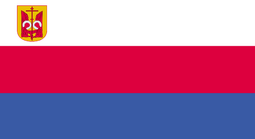 | |
| Name | Государственный флаг / Gosudarstvenny flag |
|---|---|
| Use | State flag and ensign |
| Proportion | 1:2 |
| Adopted | 1990 (introduction) 31 January 2001 (standardisation) |
| Design | A horizontal tricolor of white, red, and blue; charged with the lesser Coat of arms in top left |
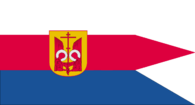 Civil flag | |
| Name | Гражданский флаг / Grazhdansky flag |
| Use | Civil flag and ensign |
| Proportion | 1:2 |
| Adopted | 2001 (current version) |
| Design | Horizontal tricolour of white, red, and blue of swallowtail design, with the coat of arms in the centre |
The flag of Dulebia (Dulebian: Флаг Дулебии, tr. Flag Dulebii), officially The State flag of Republic of Dulebia (Dulebian: Государственный флаг Республики Дулебия, tr. Gosudarstvenny flag Respubliki Dulebiya)) is the official civil and state flag representing Republic of Dulebia. It is a tricolour consisting of three equal horizontal bands, white on the top, red ribbon in the middle, and blue on the bottom. The combination of these three colours was used to symbolise the Dulebian nation ever since the adoption of the first official flag of the Kingdom of Dulebia in 1462. The first tricolour using these colours, however, was adopted in 1721, as the state flag of the Dulebian Empire, however, the colours were placed in different order. The flag gained its current shape after Konev's reformations and the adoption of the second Constitution of People's Republic of Dulebia in 1928. In the top left corner of the flag the national Coat of arms of Dulebia is placed, featuring the two Archangels of Dulebia holding the Dulebian cross and thus forming a trident, the ancient symbol of the Principality of Ulich. The positioning of the Coat of arms copies the position of the State emblem of People's Republic of Dulebia on the state flag of the country used between 1928 and 1990.
The meaning of the colours of the Dulebian flag was standardized in the 2001 Constitution, however, it is strongly disputed if the colours actually beared those meanings in the previous alterations of the flag. White on the flag symbolises the peace and harmony, as well as the freedom of the Dulebian people. The red ribbon is used as the symbol of bravery of the defenders of Dulebia, the blood spilled by Dulebians to protect their sovereignity, and as a reminder of the blood spilled during the revolutions in the 20th century. Blue symbolises the purity of the Dulebian land, the Karsk sea, and is also used as the colour symbolising God in "INSERT RELIGION".
While the three colours of the Dulebian flag predate the Dulebian empire and were first introduced in the Middle ages, both their meaning and positioning was constantly changed together with the form of rule in the country. The tricolour was introduced for first time in the Dulebian empire after the reforms of Peter II, however, in that version the red was on top, while white was in the middle. The tricolour reappeared heavily modified as the first flag of the Dulebian Socialist Federative Republic, where blue and white were once again swapped, red became the dominant colour taking up more than half the height of the flag, and white five-point star appeared in top-left. The flag was once again modified in 1928 when it received its current set-up, with only minor modifications made after the fall of socialism in Dulebia.
Design
The Dulebian national flag is a horizontal tricolour flag, with the Coat of arms of Dulebia placed in the top left corner entirely within the white stripe. The three stripes are equally sized. The flag has a 1:2 ratio. It utilizes 5 colours in total, which are as follows:
| Scheme | White | Red | Blue | Yellow | Blackα |
|---|---|---|---|---|---|
| Pantone | X | 199C | 3590C | 123C | X |
| CMYK | X | 0-100-72-13 | 65-45-0-35 | 4-24-95-0 | X-X-X-100 |
| RGB | 255-255-255 | 221-0-62 | 57-90-165 | 255-199-44 | 0-0-0 |
^α Used as outline for the elements within the Coat of arms, but can occassionally be dropped in some versions of the flag.
History
Principality of Ulich
The first recorded flag that was used to represent the Principality of Ulich was a blue banner with golden symbol drawn on it resebling a trident, a symbol that was later representing the city of Ulich. The origin of the banner, as well as the actual symbolism behind it, is unknown. It was found on a Lavarian map made by the merchant Ricardo Avelar, possibly created in 1041. Scientists thus suggest, that the flag was the personal banner of Prince Gavriil II, and that he adopted it as the flag of the Principality once he was throned in 1036. However, no records of the banner have survived until our days, and even the existence of this banner cannot be completely confirmed by scholars. Still, the theory that this flag was used as state flag has a lot of supporters, and it explains why a trident-like symbol later became standardized as royal symbol in the country up until the Dulebian Civil War in early 20th century.
Kingdom of Dulebia
The first flag of unified Dulebia came into existence in 1462 with the reforms of Tsar Mikhail III, when the first codex of the kingdom was accepted. Tsar Mikhail III initiated a series of reforms that copied the reforms held earlier in neighbouring Lavarian kingdoms. Among the reforms was the introduction of the first standardized banner. According the royal codex, "the banner should be used in time of war, official visits, on official ceremonies and festivals, and should be displayed in the royal palace", for the first time in Dulebian history a flag protocol was created. The flag itself consisted of two stripes, red and blue, and a symbol resembling a trident or fortress tower in the centre of the banner. Drawings of the banner show it both as rectangular and swallowtail, and there are no mentions whether the shape itself was standardized, suggesting that the shape was not a part of the protocol. The banner appeared on numerous Medieval paintings and in several chronicles.
The meaning of the symbol, however, remains a mystery for the experts. In the description of the flag by Mikhail III, the symbol is mentioned only once as "the emblem of the holy City of Ulich", its meaning was not explained, which brings up the conclusion that the symbol was aready used for a long period of time and was associated with Ulich itself. Similar to the flag of the Principality of Ulich, this symbol resembles a trident. In this case, however, historians have also identified several other city emblems and flags throughout Dulebia dating from the same period, all of which featured a similar symbol. In some cases it was further stylized to resemble a guard tower, and the current emblem of the city of Volynsk, which remained unchanged ever since the 13th century, features a tower, which can lead to the conclusion that the symbol at the time was used in Dulebian heraldry to represent castles and towers rather than tridents.
Dulebian Empire
The Dulebian flag received a more modern outlook following the "Westernisation" reforms of Peter II the Reformator in 1721. Inspired by the flags of Mascyllary duchies and by the flag of the neighbouring Lavarian empire, the emperor decided to rework the outdated flag. Around the same time, Dulebia conquerred the tribes inhabiting the coast of the Karsk sea, led one successful war against the Cuthlandish empire, the strongest colonial power in the world at the time, and Peter II showed the neighbours of Dulebia that his country has growing ambitions in the colonisation of the world. The reformed empire soon constructed its fleet, which needed a new flag. The selection of Peter II fell on the horizontal tricolour, inspired mostly by northern states. The new flag preserved the old colours of the flag of the Dulebian kingdom, the red-blue-white combination. However, they were rearranged. Red was put on the top, as a symbol of the bravery and power of the Dulebian army. White, put in the centre, symbolised the purity of the new empire over the old kingdom, and also was used as symbol of unification of Dulebia with the western powers admired by Peter II. The blue in the bottom symbolised, before all, the Karsk sea and the naval ambitions of the new empire.
During the rule of Peter II Dulebia also received its first official national symbol: the two-headed imperial eagle, bearing the shield with the trident of Ulich: at the time the symbol dating back to the Principality of Ulich had mutated to a point when its origin was already uncertain. Peter II, however, supported the hypothesis that originally it was a trident that was used as symbol of the Medieval principality. The trident was reworked and redrawn by heraldists invited from Lavaria. The red shield with golden trident became the symbol of Ulich, which was the heart of the new empire. The red shield with golden trident, on par with the imperial symbols: the sword and the orb, were held by a black two-headed imperial crowned eagle. This emblem was placed on the imperial flag; the resulting flag was used as civil and military flag. The naval flag, however, did not display the eagle - instead, it was only a horizontal tricolour.
Both the imperial coat of arms and the flag itself received several modifications throughout the next two centuries: an attempte to simplify the eagle, followed by return to the original display and even the adding of new decorative elements: the royal chain of Kamianets and the new imperial crown, the modification of the bright red colour used in the flag to the more noble bordeaux, and the transition from 1:2 to 2:3 ratio for the flag.
Dulebian Socialist Federative Republic
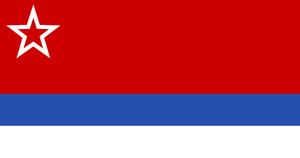
Social unrest following the poor performance of the Dulebian army and elite during the Great war resulted in the rise of socialist movement in the country. Socialists in Dulebia adopted red as their primary colour. Red had numerous meanings for the worker movement in the country: it symbolised the blood spilled on the frontlines and during the struggle for civil rights, the valour and honour of the worker's movement, the fire of the starting world revolution, and the equality of all people in the bright future that the workers of today are building. Thus, it became the primary colour for the new flag of the newly-formed communist state. While simple red flags, red flags with white or gold stars and white flags with red stars were associated with the revolutionary movement in the early stages of the revolution and the civil war in the country, soon a standardized national flag was proposed by Viktor Shchyukin. The flag returned to the original 1:2 ratio of the first flag of Peter II; red took 1/2 of its height, while blue and white were placed in the bottom, taking the other half. A white star was introduced in the top-left corner. The flag was never oficially standardized: the stars on different flags had different sizes; some were made only as outlines, others were also filled with white; the size of the red stripe could vary from flag to flag (the one displayed features an 11:7 ratio of red). The flag remained in usage even after the death of Shchyukin, and was changed after the acception of Konev's constitution in 1928.
People's Republic of Dulebia
Konev, head of the communist party of Dulebia, led a number of repressions among the party elite loyal to Viktor Shchyukin, following the latter's death in 1919. Konev was a known opponent of the federalisation doctrine of Shchyuking, and the mysterious death of the first leader of communist Dulebia allowed Konev to get rid of all the supporters of the federation. The old flag, introduced by Shchyukin and used while the country was briefly a federation between 1914 and 1919, was strongly associated with the Dulebian federalism and thus Konev considered it necessary to get rid of the old symbol. On 15th of March 1928, an updated descpription of the Dulebian flag and state emblem were included in the new constitution of Konev: the flag remained a horizontal tricolour, and even the old colours were reused, however, it was rearranged: the stripes were made of equal size, white sobstituted red as the top colour, and the white star was changed to the new state emblem, which itself was heavily modified in comparison to the old emblem of the Federative Republic. This design remains virtually unchanged until today, with only minor modifications made to the flag since the fall of communism in 1990.
Modern day
Following the dissolution of the communist regime in 1990, and the rise of democratic movements across the country, a need for a symbol of the new democratic era arose. During the early protests against the communist regime, the old imperial tricolour often appeared among protesters. The flag with the remover eagle became the symbol of the democratic country, and its reintroduction as state flag was widely supported by citizens. However, the resolution of its establishment as state flag was declined by the Council of People's Representatives in 1990, and a compromise had to be made. A new state flag was proposed by the government of Beglov: a simplified version of the old communist flag, with the removed communist symbols, ratio changed to 11:23, the dark blue changed to azure, and the old bright red changed into more pink in outlook red ribbon/crimson colour.
The flag was changed for a last time in 2001 during the amendments of the Dulebian constitution. A proposal by the ruling socialist party and president Alexey Volodin to return the "historic outlook and traditional composition" of the Dulebian flag was met with acceptance from the Dulebian population. A national contest was started prior to the constitution referendum; accordin to the official task, the new flag had to "introduce historic symbols of the Dulebian state and unite them with the current design". Three designs were selected by a government commission and were displayed to the public in August 2001. Following a public voting, a variant of the flag, which used the current colour arrangement, but changed the azure blue to the old dark blue colour, and introduced a stylized trident coat of arms in the top left corner, was selected. For the first time in the history of the Dulebian flag, more than three colours were used (excluding the flag of 1928 where the state emblem was composed of a wide variety of colours) Its description was later added to the constitution, while the emblem became so popular that it was eventually used as the new coat of arms of the country. This design serves as state flag until today.
The design is standardized and a single flag is used officially as a civil flag, state flag, on international meetings, during military parades and in time of war. The flag received an updated protocol of usage.
Related flags
Ensign of the Dulebian Armed Forces
Flag of the Royalists during the Dulebian Civil War
Flag protocol
State flag
The state flag of the Republic of Dulebia should be flown in front of state buildings and on state building roofs. It can also be flown constantly above war monuments and on special postaments. Government buildings in every city should fly the flag from the second floor windows above the entrance (if such are present) during several state holidays. Citizens are allowed to wave civil flags from the windows of their homes during the day of Dulebian independence.
The flag has a strict protocol of how it should be displayed along other state flags. On international meetings on the territory of Dulebia, the flag should always be situated on the viewer's left: this includes flags placed in front of buildings, on building entrances, and in rooms inside buildings. In the case of display of crossed flags, the Dulebian flag staff should always be in front of all other flags. If hoisted among two other flags, the flag of Dulebia should be situated in the middle.
When flown vertically, the white part should be attached to the staff, with the coat of arms being closer to the ground.
Respect to the flag
The flag of Dulebia is protected by the Constitution of the country. The criminal code of Dulebia defines what should actions regarding the state flag are prohibited, while the flag protocol defines how it should not be flown.
No part of the state flag should touch the ground when flown. It is prohibited to use the flag as tablecloth, towells, carpets, vehicle covers, tents, etc. All state flags used for government buildings should be in good shape, flying them at night (unless illuminated) and in bad weather conditions should be avoided. Any type of intentional damage of state flags (burning, tearing, detachment from the staff, drawing on the flag) are prohibited and punished according to the Dulebian criminal code.
See also
- Dulebia, country in Berea

